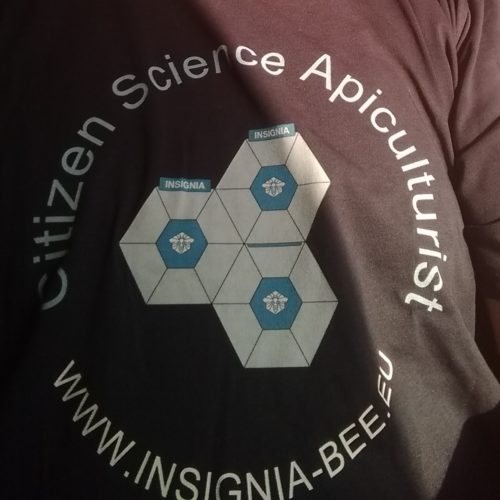To estimate the colony strength, citizen scientists count the occupied beelanes in each hive for every sampling round.


Robert Brodschneider & Kristina Gratzer

PREPARATORY ACTION FOR MONITORING OF ENVIRONMENTAL POLLUTION USING HONEY BEES
To estimate the colony strength, citizen scientists count the occupied beelanes in each hive for every sampling round.


Robert Brodschneider & Kristina Gratzer
Austrian citizen scientist Matthias is proud to keep bees in all 23 city disctricts of Vienna! For INSIGNIA he has chosen an apiary at the eastend of the city. His beekeeping operation https://www.wiener-bezirksimkerei.at/ indeed offers different honeys from all boroughs. During sampling round 2, he filmed himself taking samples on one of the INSIGNIA hives!
Continue reading “Get to know Austrian citizen scientists #3”

In my virtual meetings with the beekeeper citizen scientists, I am asked sometimes: “what is in it for me?” A fair question. Let me explain what is in it for you… You will sample pollen and APIStrips from two colonies on ten occasions. Pollen and APIStrips will be analyzed at the apiary level; pollen for botanical identity and the APIStrips for pesticide residues in the hive. These results will be shared with you and will give you the information about what plants your bees have collected pollen from, and what pesticides your bees have brought along with the pollen and nectar. The latter is qualitative, meaning yes/ no pesticide present in the APIStrip. We detect different amounts but what this means for the actual exposure of your bees in the hive can’t be told with these data. This requires another study set-up which hopefully can be done in the future. Now the reward in monetary terms. Each APIStrip with its analysis costs about €200 each, and each pollen analysis also costs about €200. So together this is €400, with transport, administration, quality control, statistics and reports not included. A very cautious estimate of the costs per beekeeper for Insignia will be 10 sampling x € 400 plus extra costs = €4,500. 60% of this is paid by the European Union = € 2,700, the remainder €1,800 is paid by your national coordinator’s institute and you will have this information about your bees for free. Continue reading “Dear participant of the Insignia study 2020”

In the former blogs you can read and understand the importance of the APIStrips in the INSIGNIA project. A strip that does collect the pesticides in the hives brought home by the foraging bees. One of the exciting success of the INSIGNIA project last year. We did test a lot of strips in the 4 countries last year.
New strips were produced this year and you could say with small improvement, but very important improvements. Improvements that make the strip easy to handle for the beekeeper.
The first strips last year were bended, rounded. Difficult to explain, but you could say the strip did fill up the whole bee space. Was a bit difficult to get down between the bee frames. This year they are perfect in shape. Straight, flat. Just easy, easier to insert in the colony.
And another feature is that in the new strips, the Tenax does not cover all the strip. So that you as user can touch the strip and in this way, it is again more easy and more safe to handle the strip. No contamination.
Small things, but the success is in the small details. This year strip is better and easier and safer to handle. Well done.
Flemming Vejsnæs


Many people have been asking about the APIStrips, which are a key feature of the INSIGNIA project. A paper describing the strips has now been published in the journal: “Science of the Total Environment” written by María Murcia-Morales and Amadeo Fernández-Alba from the University of Almeria, Spain, and colleagues from Denmark and the Netherlands.
Honey bee colonies have been shown to be effective bio-samplers of contamination within their foraging area, as organic compounds such as pesticides will be continuously deposited in their hives. The use of honey bee colonies for the biomonitoring of contaminants usually requires the sampling of biological materials from the hives such as bees, pollen, honey or beeswax. “Active” sampling in this way will inevitably affect the colonies, especially if the sampling is at regular intervals. As an alternative, the team at the University of Almeria devised the APIStrip (Adsorb Pesticide In-hive Strip). This a non-biological sampler which consists of a plastic strip coated with Tenax TA, a stable material which is exceptionally effective at adsorbing pesticide residues. A process of dissolving the Tenax in a solvent before coating the strips ensures that the bees cannot remove it. The pesticides and related contaminants adsorbed onto its surface can then be extracted and analyzed by chromatography and mass spectroscopy. It has been found that a 14 day exposure of the strips is optimal, and that the pesticides collected on the strip are stable. In the first year of the INSIGNIA Project, 2019, the APIStrips were compared with another passive device, the Beehold Tube, and two hive products, pollen and beebread. The APIStrip was found to be the most effective in collectring pesticide residues. Field studies in Denmark, over a six month period demonstrated their value and applicability by detecting 40 different pesticides.
In the 2020 study, APIStrips are being used in two honey bee colonies at nine sites in each of nine countries: Austria, Belgium, Denmark, France, Greece, Ireland, Italy, Latvia and the UK, and in bumble bee colonies in the Netherlands. The results for pesticide residues will be combined with information about the crops and wild plants on which the bees have been foraging using trapped pollen analysed using a DNA metabarcoding technique. Pollen samples and APIStrips were collected from the bee colonies last weekend, the first of ten scheduled sampling periods in 2020.
The paper: “APIStrip, a new tool for environmental contaminant sampling through honey bee colonies” is available here: https://www.sciencedirect.com/science/article/pii/S0048969720324657